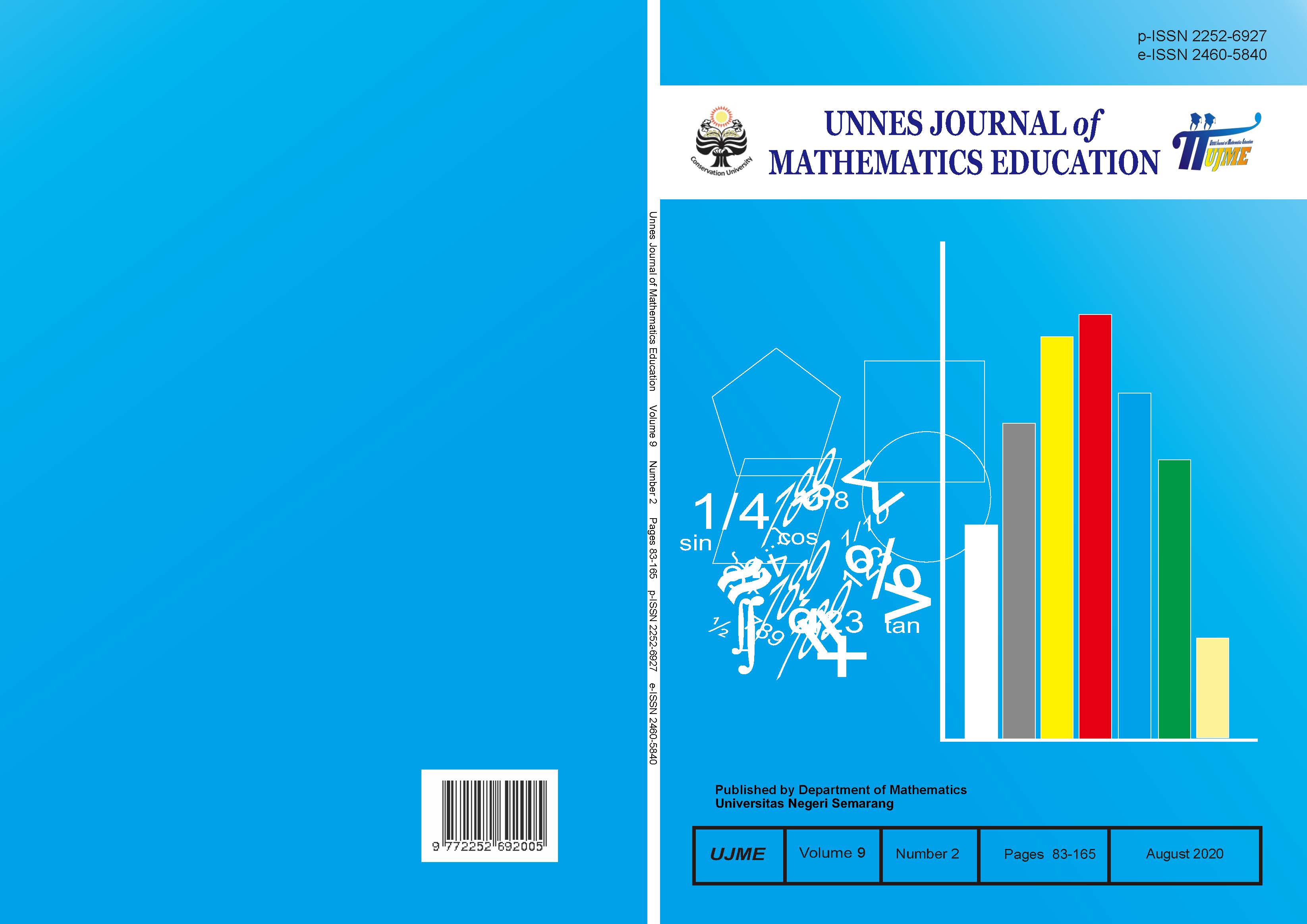The development of Augmented Reality-based learning media to improve students’ ability to understand mathematics concept
##plugins.themes.academic_pro.article.main##
Abstract
This research aims to develop an Augmented Reality-based learning media. This research is a type of development research. The development model used is the ADDIE model, which consists of five stages, namely, analysis, design, development, implementation, evaluation. The results of this study are in the form of cards that have been coded, Augmented Reality applications in Android, and student guide worksheets. The results of the validation of media and material experts indicate that this Augmented Reality-based learning media product is valid and feasible to use. The use of Augmented Reality based learning media in learning activities can improve students understanding of mathematical concept ability. This can be seen from the average n-gain obtained 0.61, which is included in the height category. Each indicator of the concept of understanding also shows big and medium improvement. This Augmented Reality based learning media also gets positive responses from students with an average percentage score of 87.50%.
##plugins.themes.academic_pro.article.details##
References
Coimbra, M. T., Cardoso, T., & Mateus, A. (2015). Augmented Reality : an Enhancer for Higher Education Students in Math ’ s learning ? Procedia - Procedia Computer Science, 67(Dsai), 332–339. https://doi.org/10.1016/j.procs.2015.09.277
Hake, R. R. (1998). Interactive-engagement versus traditional methods: A six-thousand-student survey of mechanics test data for introductory physics courses. American Journal of Physics, 66(1), 64–74. https://doi.org/10.1119/1.18809
Harti, L. S., & Agoestanto, A. (2019). Analysis of algebraic thinking ability viewed from the mathematical critical thinking ablity of junior high school students on problem based learning. Unnes Journal Of Mathematics Education, 8(2), 119–127. https://doi.org/10.15294/ujme.v8i2.32060
Haryadi, R. (2019). Briquettes production as teaching aids physics for improving science process skills. Journal of Physics: Conference Series. https://doi.org/10.1088/1742-6596/1157/3/032006
Haryadi, R., & Pujiastuti, H. (2020). PhET simulation software-based learning to improve science process skills. Journal of Physics: Conf. Series. https://doi.org/10.1088/1742-6596/1521/2/022017
Hornburg, C. B., Rieber, M. L., & McNeil, N. M. (2017). An integrative data analysis of gender differences in children’s understanding of mathematical equivalence. Journal of Experimental Child Psychology, 163, 140–150. https://doi.org/10.1016/j.jecp.2017.06.002
Ibáñez, M. B., & Delgado-Kloos, C. (2018). Augmented reality for STEM learning: A systematic review. Computers and Education, 123, 109–123. https://doi.org/10.1016/j.compedu.2018.05.002
Kurniawan, M. H., & Witjaksono, G. (2018). Human Anatomy Learning Systems Using Augmented Reality on Human Anatomy Learning Systems Using Augmented Reality on Mobile Application Mobile Application. Procedia Computer Science, 135, 80–88. https://doi.org/10.1016/j.procs.2018.08.152
Mahony, S. O. (2015). A Proposed Model for the Approach to Augmented Reality Deployment in Marketing Communications. Procedia - Social and Behavioral Sciences, 175, 227–235. https://doi.org/10.1016/j.sbspro.2015.01.1195
MartÃn-Gutiérrez, J., Fabiani, P., Benesova, W., Meneses, M. D., & Mora, C. E. (2015). Augmented reality to promote collaborative and autonomous learning in higher education. Computers in Human Behavior, 51, 752–761. https://doi.org/10.1016/j.chb.2014.11.093
Meltzer, D. E. (2002). The relationship between mathematics preparation and conceptual learning gains in physics : A possible ‘“ hidden variable â€â€™ in diagnostic pretest scores. American Journal of Physics, 1259–1268. https://doi.org/10.1119/1.1514215
Mota, J. M., Ruiz-Rube, I., Dodero, J. M., & Arnedillo-Sánchez, I. (2018). Augmented reality mobile app development for all. Computers and Electrical Engineering, 65, 250–260. https://doi.org/10.1016/j.compeleceng.2017.08.025
Munoo, R., & Abdullah, R. (2018). Adding ADDIE to the Library Orientation Program at Singapore Management University Libraries. In Planning Academic Library Orientations. https://doi.org/10.1016/B978-0-08-102171-2.00027-1
Ozdilek, Z., & Robeck, E. (2009). Operational priorities of instructional designers analyzed within the steps of the Addie instructional design model. Procedia - Social and Behavioral Sciences, 1(1), 2046–2050. https://doi.org/10.1016/j.sbspro.2009.01.359
Pujiastuti, H., & Fitriah, F. (2019). Design of interactive teaching materials based on a scientific approach to support junior high school students’ learning: Line and angles. Journal of Physics: Conference Series, 1157(3). https://doi.org/10.1088/1742-6596/1157/3/032087
Pujiastuti, Heni, Ayatullah, F., & Haryadi, R. (2019). The Influence of Inquiry Learning Model towards Students ’ Mathematical Critical Thinking Ability. Unnes Journal Of Mathematics Education, 8(3), 216–223. https://doi.org/10.15294/ujme.
Pujiastuti, Heni, & Haryadi, R. (2019). Interactive Math E-Book : An Alternative Learning Resources for 21 st Century Learners. European Union Digital Library. https://doi.org/10.4108/eai.21-11-2018.2282046
Pujiastuti, Heni, & Haryadi, R. (2020). The Use of Augmented Reality Blended Learning for Improving Understanding of Food Security in Universitas Sultan Ageng Tirtayasa: A Case Study. Jurnal Pendidikan IPA Indonesia T, 9(1). https://doi.org/10.15294/jpii.v9i1.21742
Pujiastuti, Heni, Suviati, D., Haryadi, R., & Marethi, I. (2020). Development of mathmodule based on local wisdom and 21 st century skills : linear equation system. Journal of Physics: Conf. Series. https://doi.org/10.1088/1742-6596/1480/1/012052
Pujiastuti, Heni, Utami, R., & Haryadi, R. (2020). The development of interactive mathematics learning media based on local wisdom and 21st century skills : social arithmetic. Journal of Physics: Conference Series. https://doi.org/10.1088/1742-6596/1521/3/032019
Rau, P. L. P., Zheng, J., Guo, Z., & Li, J. (2018). Speed reading on virtual reality and augmented reality. Computers and Education, 125(April), 240–245. https://doi.org/10.1016/j.compedu.2018.06.016
Salinas, P., & Pulido, R. (2015). Visualization of Conics through Augmented Reality. Procedia - Procedia Computer Science, 75(81), 147–150. https://doi.org/10.1016/j.procs.2015.12.231
Sharifah, R., & Faaizah, S. (2015). The Development of Online Project Based Collaborative Learning using ADDIE Model. Procedia - Social and Behavioral Sciences, 195, 1803–1812. https://doi.org/10.1016/j.sbspro.2015.06.392
Trifonov, G. M., Poyda, A. A., Andreev, A. A., Prosvetov, A. V, Andreev, A. A., & Prosvetov, A. V. (2018). ScienceDirect Nocturnal Lights : object-oriented catalog of the nighttime Earth Nocturnal Lights : object-oriented catalog of the nighttime Earth light sources light sources Mikhail. Procedia Computer Science, 136, 91–98. https://doi.org/10.1016/j.procs.2018.08.241
Tsai, C. Y. (2019). Improving students’ understanding of basic programming concepts through visual programming language: The role of self-efficacy. Computers in Human Behavior, 95, 224–232. https://doi.org/10.1016/j.chb.2018.11.038
van Esch, P., Arli, D., Gheshlaghi, M. H., Andonopoulos, V., von der Heidt, T., & Northey, G. (2019). Anthropomorphism and augmented reality in the retail environment. Journal of Retailing and Consumer Services, 49(December 2018), 35–42. https://doi.org/10.1016/j.jretconser.2019.03.002
Zuin, M., Rigatelli, G., Faggian, G., & Roncon, L. (2018). Mathematics and thrombolysis: Role of the mathematical modelling in understanding and developing blood clot fragmentation. European Journal of Internal Medicine, 54(June), e19–e20. https://doi.org/10.1016/j.ejim.2018.06.003
